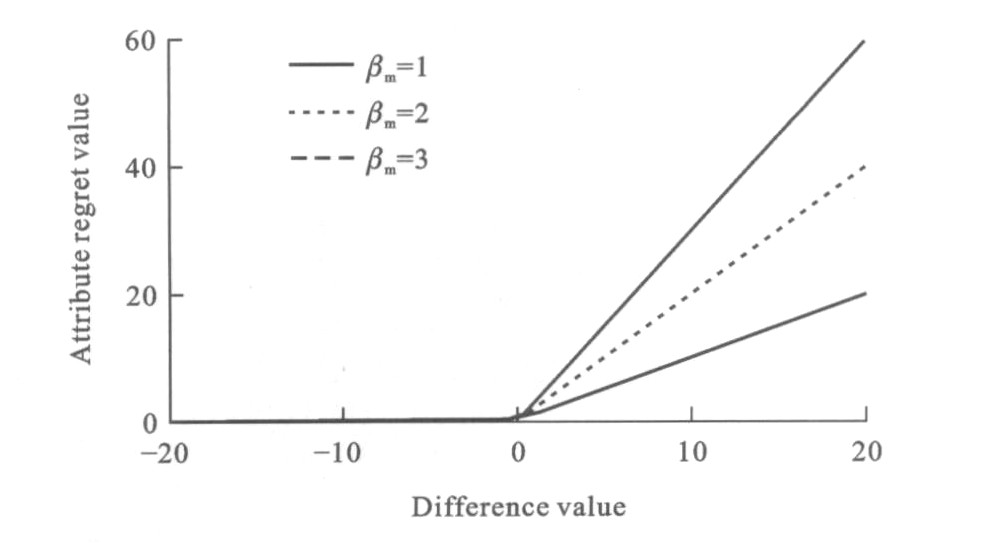-
摘要: 应用随机后悔最小化理论与随机效用最大化理论, 分别建立RRM-MNL模型和RUM-MNL模型研究了出行方式选择行为。在模型参数、拟合优度方面对2个模型进行了比较, 应用直接弹性分析了在交通管理措施评价方面的区别, 并通过城际出行方式中的飞机、火车、长途汽车、小汽车4种出行方式数据进行实际验证。分析结果表明: 相比于RUM-MNL模型, RRM-MNL模型能够描述在多属性方案选择过程中的部分补偿性决策行为和折衷效应, 能更真实地反映实际出行行为选择过程; 等待时间、出行时间和出行费用对飞机、火车和长途汽车3种出行方式的选择概率都具有弹性; 在RRM-MNL模型中, 等待时间对3种方式的弹性值分别较RUM-MNL模型的低7.30%、13.14%和7.70%。可见, 对于同一属性变量, 出行者具有不同的选择偏好, 会表现出不同的选择行为。Abstract: Based on random regret minimization(RRM) theory and random utility maximization(RUM) theory, RRM-MNL model and RUM-MNL model were set up to research the choice behaviors of travel modes respectively.Aiming at RRM-MNL model and RUM-MNL model, the parameters and the goodnesses of fit were compared, their difference on the evaluation of traffic management measures was analyzed through direct elasticity, and practical verification was carried out based on four travel data such as aircraft, train, coach and car during intercity travel.Analysis result shows that compared with RUM-MNL model, in RRM-MNL model, the partial compensatory decision-making behavior and compromise effect during the choice process of multi-attribute method are described better, and the choice process of travel behavior can be reflected more really.The choice probabilities of wait time, travel time and travel cost on three travel methods such as aircraft, train and coach have significant elaticities.In RRM-MNL model, the elasticities of wait time for aircraft, train and coach all are lower than those in RUM-MNL model, and reduce by 7.30%, 13.14% and 7.70% respectively.So, for the same attribute variable, while the traveler has different choice preferences, the different choice behaviors will be displayed.
-
Table 1. Sharing ratios
Travel method Sharing ratio/% Aircraft (method 1) 30.10 Train (method 2) 28.62 Coach (method 3) 27.00 Car (method 4) 14.28 Total 100.00 Table 2. Definitions of model variables
Variable Definition T1 Wait time(min) T2 Travel time(min) C1 Travel cost (yuan) C2 Household income (1 000 yuan) S1 Intrinsic constant of aircraft S2 Intrinsic constant of train S3 Intrinsic constant of coach Table 3. Comparison of calculation results
Variable Attribute RUM-MNL model RRM-MNL model Estimate value t-test value Estimate value t-test value S1 Intrinsic constant of method 1 3.926 0 3.907 -2.470 0 -8.233 S2 Intrinsic constant of method 2 3.871 0 8.255 -1.948 0 -6.115 S3 Intrinsic constant of method 3 3.244 0 7.077 -1.484 0 -2.103 T1 Common variable -0.095 8 -9.278 -0.036 0 -8.847 T2 Common variable -0.004 1 -4.748 -0.004 3 -6.445 C1 Common variable -0.012 8 -2.015 -0.010 6 -2.686 C2 Specific variable of method 4 0.016 5 2.544 -0.018 8 -2.179 Likelihood ratio only with constant -291.122 Likelihood ratio of results -162.617 -159.976 Information Criterion(AIC) 1.682 1.590 Table 4. Comparison result of variable elasticities
Variable RUM-MNL model RRM-MNL model Aircraft Train Coach Car Aircraft Train Coach Car T1 -4.592 -2.656 -3.611 0.000 -4.257 -2.307 -3.333 0.000 T2 -0.389 -1.852 -2.217 -1.730 -0.408 -1.752 -2.279 -1.923 C1 -0.766 -0.504 -0.367 -0.205 -0.659 -0.465 -0.252 -0.195 -
[1] ARENTZE T, TIMMERMANS H. Parametric action deci-sion-marking trees: incorporating continuous attribute vari-ables into rule-based models of discrete choice[J]. Transpor-tation Research Part B: Methodological, 2007, 41(7): 772-783. doi: 10.1016/j.trb.2007.01.001 [2] BELL D E. Regret in decision making under uncertainty[J]. Operations Research, 1982, 30(5): 961-981. doi: 10.1287/opre.30.5.961 [3] ZHANG Jun-yi, TIMMERMANS H, BORGERS A, et al. Modeling traveler choice behavior using the concepts of rela-tive utility and relative interest[J]. Transportation ResearchPart B: Methodological, 2004, 38(3): 215-234. doi: 10.1016/S0191-2615(03)00009-2 [4] GILBRIDE T J, ALLENBY G M. A choice model with con-junctive, disjunctive, and compensatory screening rules[J]. Marketing Science, 2004, 23(3): 391-406. doi: 10.1287/mksc.1030.0032 [5] HESS S, STATHOPOULOS A, DALY A. Mixing of behaviorprocesses: a modeling framework and three case-studies[C]∥TRB. 90th Annual Meeting of Transportation ResearchBoard. Washington DC: TRB, 2011: 1-18. [6] DENANT-BOEMONT L, PETIOT R. Information value andsequential decision-making in a transport setting: an experi-mental study[J]. Transportation Research Part B: Methodo-logical, 2003, 37(4): 365-386. doi: 10.1016/S0191-2615(02)00018-8 [7] LEONG W, HENSHER D A. Embedding decision heuristicsin discrete choice models: a review[J]. Transport Reviews, 2012, 32(3): 313-331. doi: 10.1080/01441647.2012.671195 [8] ARENTZE T A, TIMMERMANS H J P. ALBATROSS: overview of the model, application and experiences[C]∥TRB. Innovation in Travel Modeling 2008. Portland: TRB, 2008: 1-27. [9] JOU R C, KITAMURA R, WENG M C, et al. Dynamiccommuter departure time choice under uncertainty[J]. Transportation Research Part A: Policy and Practice, 2008, 42(5): 774-783. doi: 10.1016/j.tra.2008.01.017 [10] HANNES E, JANSSENS D, WETS G. Mental map of dailyactivity travel routines[C]∥TRB. 88th Annual Meeting ofTransportation Research Board. Washington DC: TRB, 2009: 1-17. [11] CHORUS C G. A new model of random regret minimization[J]. European Journal of Transport and Infrastructure Research, 2010, 10(2): 181-196. https://www.researchgate.net/publication/254906856_A_New_Model_of_Random_Regret_Minimization [12] THIENE M, BOERI M, CHORUS G C. Random regretminimization: exploration of a new choice model for environ-mental and resource economics[J]. Environmental andResource Economics, 2012, 51(3): 413-429. doi: 10.1007/s10640-011-9505-7 [13] CASPAR G C. Random regret minimization: an overview ofmodel properties and empirical evidence[J]. TransportReviews, 2012, 32(1): 75-92. [14] KIVETZ R, NETZER O, SRINIVASAN V. Alternativemodels for capturing the compromise effect[J]. Journal ofMarketing Research, 2004, 41(3): 237-257. doi: 10.1509/jmkr.41.3.237.35990 [15] BIERLAIRE M, FETIARISION M. Estimation of discretechoice models: extending BIOGEME[C]∥STRC. 9th SwissTransport Research Conference. Ascona: STRC, 2009: 1-21. -





 下载:
下载:





